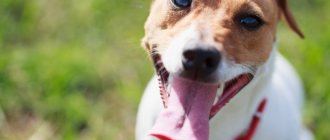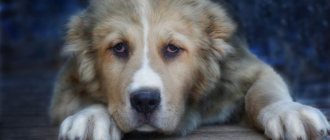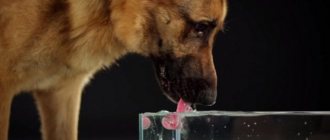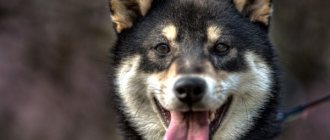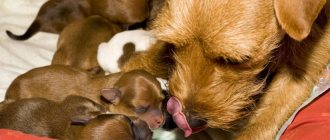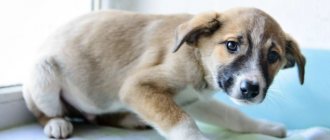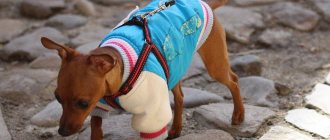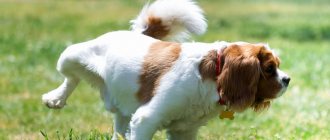Why does my dog often breathe with his mouth open?
The cause of rapid breathing can be both physiological characteristics and pathologies. This is absolutely normal if the dog is breathing frequently due to physiological changes in its body, which are associated with the need to speed up metabolism and metabolism.
Why does a dog often breathe with its mouth open?
- Such changes include excitement. That is, the dog is scared or, conversely, happy. In this case, it is quite normal for her to breathe frequently and stick out her tongue.
- After a long run or other physical activity, perhaps competition, the dog may also pant and stick out its tongue.
- Dogs in heat, like women on their period, feel a little strange and not very good.
- Blood pressure and temperature may increase. Therefore, rapid breathing during pregnancy, childbirth, and estrus is absolutely normal. High ambient temperature.
A pet
The dog is breathing quickly and is hot: reasons
However, if your dog is in a calm state, not nervous, it’s a cold season outside, but still often breathes with its mouth open, perhaps the reasons are pathological and indicate serious illnesses.
The dog is breathing quickly, hot, reasons:
- Entry of foreign bodies into the respiratory tract. This may be a neoplasm that narrows the lumen in the bronchi and lungs, blockage, or the ingress of foreign bodies. There may be fur or small objects in the bronchi.
- Inflammatory diseases of the respiratory organs . They can be of either infectious or viral origin. Dogs also suffer from bronchitis and pneumonia, as well as viral illnesses that can cause pneumonia.
- Respiratory damage due to trauma.
- Diseases of the cardiovascular system . The heart pumps blood throughout the body, therefore, due to pathologies of the cardiovascular system, respiratory diseases can be observed.
- Broken ribs, damaged bones. Broken ribs make it difficult to breathe normally. Note the dents in the chest area. There are usually other symptoms, such as the dog's weakness, pain when pressed, and restlessness.
- When the body temperature is elevated, the dog also breathes frequently . Pay attention to this to see if your pet is sick.
- Endocrine system diseases and allergies . If you have an allergic reaction, especially to pollen or food, your dog may also sneeze and pant.
Rapid breathing
Therapy
Treatment of asthma in a dog begins with finding and eliminating the allergen. Low quality food, moldy foods, dishes with excess salt and vegetable proteins, and wheat concentrates are excluded from the dog’s menu. The diet is radically revised, enriched with missing microelements and B vitamins.
To stop attacks, a set of measures is used:
- oxygen therapy;
- adrenomimetic drugs (Adrenaline, Teofedrine);
- antispasmodics (Cordarone, Papaverine);
- antihistamines (Intal, Diprazine);
- hormonal drugs (Cortisone acetate, Metipred, Beclomet);
- restorative medications (Calcium gluconate).
How to treat asthma in dogs at home, before the veterinarian arrives? An oxygen mask will help alleviate the condition of a tailed asthmatic during an attack. The owner must keep it at home in case of force majeure. A timely injection of Theophedrine or Ephedrine will help quickly restore impaired breathing.
In addition, in the house where an asthmatic dog lives, there should always be vasodilators and antispasmodics (Papaverine, Eufillin), as well as decongestants (Suprastin, Diphenhydramine).
Veterinarians advise taking relaxing menthol inhalations when a seizure approaches. To clear the lumen of the bronchi from mucus, it is recommended to give drugs with an expectorant effect.
Particular attention should be paid to concomitant infectious diseases. If you have sinusitis, you should undergo antibiotic therapy. If polynosis is detected in the nose, you will have to resort to surgical intervention.
Why does a dog breathe frequently after giving birth?
Particular attention should be paid to a dog who has recently become a mother. The fact is that the birth of puppies is a serious stress for the body, which can cause the development of certain ailments.
Why does a dog breathe frequently after giving birth:
- It is generally accepted that increased breathing during childbirth and 15 minutes after it is physiological, since it is during this period that the body needs a lot of oxygen. In the first 15 minutes after the birth of the first baby, it is necessary for the dog to produce a large amount of milk.
- It is at this moment that a lot of milk arrives in the mammary glands, and the amount of oxytocin and other sex hormones increases in the blood. All this is necessary for the birth to end safely, and for the girl to be able to give birth not only to puppies, but also to a placenta.
- If rapid breathing occurs for longer than 15 minutes, try palpating your pet's abdomen. Perhaps the rapid breathing is due to the fact that not all puppies were born. This happens if the first babies are stillborn. Perhaps labor has stopped and one or two puppies remain in the belly. You can easily determine this by palpating the lower abdomen.
Cute dog
Postpartum period
The postpartum period is a difficult time for any mother. In addition to the costs of recovery after pregnancy and childbirth, the body spends enormous resources on raising offspring. In the first 3-4 weeks, a number of problems that are typical for this period may occur to the mother. Let's look at them.
Postpartum metritis
This is a severe infectious (bacterial) inflammation of the uterus during the postpartum period. During the first 2-3 weeks after birth, the uterus is normally dilated, has a fairly loose wall damaged by the separation of the placenta, and is more susceptible to bacterial infections.
The development of pathology can be facilitated by:
weakness of labor, manual obstetrics (when puppies/kittens were actively pulled out by hand), poor sanitary conditions, retention of dead fetuses. Retained placentas are not a proven factor that increases the risk of developing postpartum metritis!
Symptoms may be
: lethargy, apathy, decreased/lack of appetite, increased temperature, discharge from the genitals with an unpleasant odor/purulent nature, loss of interest in offspring, thirst. But the symptoms can be very vague.
Normal discharge after childbirth
in dogs, the first 2-3 days are bloody and greenish-black, moderate, without an unpleasant odor, then brownish. In cats, the first 2 days are more abundant brownish-red, then scanty brownish.
The condition is dangerous; sometimes infection in the uterus leads to the development of sepsis and death of the animal. Laboratory (blood tests, vaginal cytology) and visual (ultrasound x-ray) diagnostics are required.
Retention of placenta
The placenta or afterbirth is the membranes that usually exit the birth canal with puppies/kittens or after the birth of the fetus. It is not always easy to count the number of afterbirths released - a dog/cat may unnoticed eat some of it, the other part may not come out; it happens that two puppies/kittens may have one afterbirth between them.
If the mother feels normal after childbirth, the discharge is not purulent, normal, there is no need to worry
. In the vast majority of cases, the placenta that has not been delivered disintegrates into parts in the uterus within a few days, is destroyed and is released along with postpartum discharge - lochia. That is, delayed placenta in the absence of complaints does not require therapy. A reliable way to find out whether the placenta remains in the uterus and whether it requires therapy is an ultrasound examination. Whether therapy is needed is determined on a case-by-case basis.
Remember that eating placenta by the mother after childbirth sometimes leads to severe gastroenterocolitis (vomiting, diarrhea). Avoid experiments. Gastrointestinal disorders in the mother can lead to deterioration in the condition of the puppies/kittens.
Subinvolution of placental attachment sites
Normal contraction and restoration of the uterus after childbirth is called involution
and takes approximately 12 weeks.
Subinvolution of placental attachment sites/postpartum metrorrhagia
- a condition in which the part of the uterine lining where the placenta was attached cannot “heal” completely due to placental cells remaining inside the wall. This leads to constant bleeding at the placentation site until the placental cells come out of the wall completely and the mucous membrane heals.
Typically, postpartum discharge disappears in dogs about four weeks after birth, in cats within 1-2 weeks. If the discharge decreases or stops, and then appears again, it looks like mucous mixed with blood, if the bitch has light and bloody discharge all the time after giving birth, this may indicate a violation of the involution of the uterus.
This pathology is extremely rare in cats.
Laboratory (blood tests, blood coagulation, vaginal cytology) and visual (ultrasound) diagnostics
.
Typically, such bleeding is insignificant, scanty and does not threaten the animal’s condition. Since there are no effective treatment methods developed, observation is chosen in this case. Moreover, if resolved independently, this pathology does not threaten reproductive function. If bleeding is profuse, sterilization may be necessary in rare cases.
But it is worth remembering that subinvolution, metritis and a number of other pathologies in the late postpartum period may be similar in appearance. If there is abnormal discharge after childbirth, this is always a reason to consult a specialist.
Eclampsia
Eclampsia can occur from the 45th day of pregnancy to the 3rd week after birth. The mechanism of its development is associated with an increase in the need for calcium (loss in milk, mineralization of the fetal skeleton) and the inability to quickly compensate for these needs by the body.
Taking calcium supplements in the second half of pregnancy does not prevent, and in predisposed breeds (usually small ones) only increases the risk of developing eclampsia. If during pregnancy we provide the body with a constant additional source of calcium, then the special mechanisms that are involved in the mobilization of calcium from its depot during a sharp increase in need simply do not have time to become active. As soon as the need for calcium increases, all the symptoms of hypocalcemia - eclampsia - appear. Taking oral calcium supplements when eclampsia develops usually does not help. It is absorbed from the intestines of adult animals to a limited extent, and this is not enough to meet the needs. When clinical symptoms of eclampsia occur, calcium is administered parenterally (preferably intravenously) to stabilize the patient.
Prevention of the development of eclampsia is a diet with adequate protein content (it is important for calcium transport in the body) and the correct ratio of calcium and phosphorus (which affects digestibility).
Symptoms of eclampsia can be
: increased body temperature, strange behavior, trembling, convulsions, heavy rapid breathing - shortness of breath (in cats, a symptom of hypocalcemia may be severe shortness of breath, breathing difficulties), vocalization (sometimes dogs with eclampsia simply bark continuously), unmotivated aggression.
For diagnostics
The level of ionized calcium in the blood is examined.
Total blood calcium is not always informative. This indicator is very unstable; it is optimal to do the analysis immediately after blood sampling. Treatment is possible, but requires inpatient monitoring around the clock in severe cases
. Sometimes it is necessary to stop lactation and transfer the litter to artificial feeding.
Non-infectious mastitis/galactostasis
This is stagnation of milk in the absence of bacteria in it. The breasts become enlarged and may become painful. The milk sacs or glands farthest from the head that the puppies/kittens are not actively sucking on are affected first. This disease can occur when puppies are abruptly weaned from an actively lactating bitch.
For prevention, it is worth regularly examining and palpating the dog’s mammary glands for lumps and changes in the color of the milk when pressed.
If you notice that the mammary gland has become “stony”, or its color has changed and pain has appeared
, then you should contact your veterinarian as soon as possible. It is impossible to distinguish lactostasis from mastitis externally, and the latter requires antibiotics.
If bacterial causes are excluded, then resort to massage and expressing milk until the milk bags soften. If you miss the beginning of the problem, lactostasis often turns into mastitis.
Infectious mastitis
This problem is associated with the development of infection in the breast tissue during lactation.
Predisposing factors may be
: trauma to the nipples, anatomical defects of the nipples and milk package, poor sanitary conditions, lactostasis, abrupt weaning of the litter when puppies/kittens ignore one or more packages, etc.
Symptoms of mastitis:
induration, soreness, increased temperature, redness of one or more mammary glands, lethargy, apathy (mastitis is painful), increased mother's body temperature, loss of interest in puppies/kittens, deterioration in the condition of the puppies (not hanging, diarrhea, weak).
Mastitis is one of the causes of the development of diseases in babies and “toxic milk syndrome”
.
For diagnosis, cytological examination of milk samples (smear) is used. The presence of a large number of bacteria and leukocytes confirms the diagnosis of infectious mastitis and requires prompt treatment.
Sometimes mastitis ends with the formation of a purulent cavity in the breast tissue. Then the cavity is opened and drainage is installed. Less commonly, gangrenous changes and necrosis of milk bags are possible, in which case surgical removal of the tissue may be required.
Therapy uses massage to empty the mammary gland, symptomatic treatment (pain relief, anti-inflammatory drugs, infusions, etc.), antibiotics (but their choice depends on many factors - whether lactation will be stopped, safety for babies, etc.). Sometimes it is necessary to resort to prescribing drugs to stop lactation, weaning puppies from their mother and transferring them to artificial feeding.
Agalactia/Hypogalactia
This is a complete absence or small amount of milk.
The problem may be related to
: congenital structural features of the mammary gland (not capable of producing milk), with premature birth (caesarean section performed before the onset of physiological labor), with deterioration of the mother’s condition.
If the mother does not eat well after childbirth, does not feel well, has diarrhea, vomiting, if she is under constant stress, if she is not adequately anesthetized after a cesarean section, this may be a good reason for a decrease in milk production. It is necessary to improve the mother’s well-being first. There are a number of drugs to stimulate lactation, but their effectiveness and feasibility remain not fully understood. Therefore, drug treatment should be agreed with a doctor.
Understand that there is not enough milk
will help control weight gain in newborns!
Unfortunately, lactation cannot always be brought to a normal level. Then the puppies/kittens have to be switched to mixed (when the babies are supplemented) or artificial feeding. However, this does not mean that after the next birth a similar problem will recur.
A little about “toxic milk syndrome”
This is a general concept that includes all diseases of the mother in which changes in the milk can lead to a deterioration in the condition of the puppies/kittens.
These include mastitis (babies experience episodic diarrhea), metritis (when bacterial toxins enter the milk), gastroenteritis (if the mother has gastrointestinal disorders, children often also experience diarrhea, be careful with the variety of diet of the nursing mother), any other conditions leading to maternal illness.
We understand that it can be difficult to bring a nursing female/cat to the clinic for an examination. But sometimes this is necessary to preserve the health of both mother and litter.
My dog is breathing frequently after giving birth, what should I do?
But there are also pathological causes of rapid breathing after childbirth, especially they are observed the next day or a few days later. The fact is that almost all the body’s energy reserves during this period are spent on babies, that is, milk.
The dog is breathing frequently after giving birth, what to do:
- In order to produce it in sufficient quantities, the mother’s body is literally emptied; there is no calcium or glucose left in it. That is why a decent proportion of females after childbirth are faced with a disease such as eclampsia.
- Take a close look at your pet; if, along with rapid breathing, the paws stretch out, become as if wooden, or the female cannot rise on her hind legs, limps, drags them along with her, this is a reason to urgently go to the doctor.
- It is best if you purchase a solution of glucose and calcium gluconate in advance to give the necessary injection. There are drugs that are administered intramuscularly, usually injected into the dog's thigh. The amount of product is selected depending on the weight of the pet.
A pet
Dancing Doberman disease
This neurological syndrome is characterized by flexion of one hind limb while standing. Over time, the second hind limb is affected. A sick dog bends and extends its limbs alternately, as if in a dance. It is assumed that there is a combined response to a sensory stimulus and an automatic neurological impulse. The disease occurs in Doberman Pinschers between 6 months and 7 years of age and affects both males and females. September 14, 2012
Symptoms and types
The main symptom is the bent position of one paw while standing. The second limb is usually affected after 3-6 months. When a dog changes its paws, it appears as if it is dancing. The animal cannot control it. Soon after the onset of the disease, these overactive tendon reflexes lead to progressive muscle atrophy of the limbs. Sometimes the muscles of the limbs lose the ability to respond to the dog's desire to move. This is called proprioceptive deficit.
Causes
The cause of this disease is unknown, but it is believed to be inherited recessively.
Diagnostics
Other conditions associated with Dancing Doberman disease may include lumbosacral stenosis (a narrowing of the lower part of the spinal canal that compresses the nerve roots) or an infection of one or more bones in the spine or the intervertebral discs that connect them in the lumbar region (intervertebral disc disease and discospondylitis, respectively). Dancing Doberman disease is usually painful. A veterinarian can also diagnose cancer of the lumbar spinal cord or nerve endings. This condition progresses quickly and can be painful.
Diagnostic procedures include electromyography (recording the electrical activity of muscles) and testing the amount of uncontrolled muscles and nerves (fibrillation). The veterinarian examines the transmission of information from sensory to motor centers (nerve conduction velocity) to determine the severity of the disease. He will also take a sample of muscle tissue behind the knee joints to examine for muscle disease and/or nerve damage.
Treatment
There are no methods to control the clinical symptoms of this disease or slow its progression.
After that
Several patients were followed for five years or more and remained acceptable pets.
The dog is breathing heavily and frequently, what should I do?
Quite often, the cause of heavy breathing in a dog is heart problems. They usually appear in dogs over 8 years of age. Indeed, mature dogs can suffer from cardiovascular diseases.
The dog is breathing heavily and frequently, what to do:
- While walking, running, or active games, the dog gets tired very quickly and sticks out its tongue. Take a closer look at the color of the tongue. If it is blue, the dog most likely has heart problems. However, it is also necessary to pay attention to how the pet behaves.
- The accompanying symptoms can tell a lot. If this is an infectious disease, the dog may tremble, its performance decreases, and any desire to have fun, walk or run disappears.
- If previously your pet happily enjoyed a walk in the park and chased abandoned sticks, now he is very lethargic, trying to go into the shade and lie down. In this case, you need to pay attention to his breathing and body temperature.
- If you fed your dog unusual food, perhaps he picked up something on the street, after which rapid breathing, vomiting and diarrhea appeared, this indicates poisoning. It is necessary to rinse the dog’s stomach and give several tablets of activated carbon.
- The injury is difficult to miss; most often it manifests itself as damage to the skin, or uncharacteristic changes in the contours of the body. What usually happens with closed rib fractures.
On a walk
Preventive actions
Owners of puppies should accustom their puppies to high-quality food from the first days. You cannot deprive your pet of vitamin B1 and animal proteins. It is necessary to completely exclude salted foods from the diet of a dog with heart problems.
It is equally important to maintain an optimal microclimate in the room where your pet is kept: ventilate daily, humidify the air, wipe off dust, and wash the floors.
You shouldn’t let your four-legged friend become overtired during training. It is contraindicated to expose to unnecessary emotional stress. Compliance with routine immunization will save you from infectious diseases and their unpleasant consequences.
It is unlikely that you will be able to completely get rid of asthmatic attacks. But with the right approach, they can be effectively stopped. This will enable the four-legged patient not to experience much discomfort from his illness.
Dogs are emotional animals that can make many different sounds. They bark, howl, whine, squeal, growl, expressing their emotions. At the same time, many dogs snore in their sleep, and after waking up the dog may grunt and sneeze. In some cases, such sounds are caused by the anatomical structure of the nasopharynx and the physiological characteristics of the body. But what to do if the dog is choking, sneezing, coughing, grunting, breathing heavily and intermittently?
Why does my dog pant and whine frequently?
Frequent breathing, which is characterized by wheezing, whistling, and shallow breathing, indicates that the dog is sick with a viral or bacterial disease. She has pneumonia or bronchitis. Usually a whistling, short sound is heard when exhaling. Very often, before these symptoms, the dog experiences nasal discharge. Most likely, pneumonia is provoked by an exacerbation and deterioration in health after a viral infection.
Why does a dog pant and whine frequently?
- Frequent breathing can be caused by parasites. Oddly enough, infection with worms affects not only the state of the dog’s digestive system, but also the functioning of a large number of organs.
- The fact is that some types of worms live not only in the gastrointestinal tract. Some of them live in the dog's lungs. Therefore, parasites can provoke coughing, sneezing, and rapid breathing.
- Wheezing may be heard and symptoms similar to bronchitis may be observed. However, most often, infection with worms is not accompanied by a high temperature. Usually all vital signs are normal, but the dog becomes lethargic and may wheeze.
- In this case, you need to consult a doctor and be examined for worms. Much attention should be paid to this if you switched from artificial food to natural food and gave your dog raw meat.
At the doctor's appointment
When is a visit to the vet necessary?
A visit to a canine doctor is required for animals with the following clinical signs:
When visiting the clinic, your pet will undergo a full examination and diagnostic examination, which will help to understand the cause of the deviation. Identifying diseases at the primary stages of development gives a better chance of recovery. Ignoring obvious symptoms will lead to the pathology becoming chronic, and in worst cases, to the death of the animal.
It is impossible to accurately determine the source of muscle contractions in a pet without diagnostics - the doctor is based not only on visual examination data, but also on the results of laboratory tests. Many owners make the mistake of mistaking pathology for physiological manifestations, wasting precious minutes.
Why does a pregnant dog pant rapidly?
A dog's pregnancy can cause rapid breathing. This symptom appears around 57-60 days of pregnancy.
Why does a pregnant dog breathe frequently?
- This suggests that the dog is really preparing for childbirth, perhaps she is having contractions.
- Along with rapid breathing, other symptoms may also occur, such as licking a loop, tension in the lower abdomen.
- This all indicates the beginning of labor.
Journey
Physiological features of toy terriers
The Toy Terrier is a small (also called “pocket”) dog, with an average height of 20-30 cm and an average weight of 1.5 to 3 kg.
live from 12 to 15 years . These pets are thin-boned, with high legs, square in shape with angular muscles. A wedge-shaped head, a rounded skull and a convex wide forehead are also characteristic features of the breed.
Read more about what Toy Terriers look like here.
To establish proper dog breathing, the transverse cartilaginous half-rings of the trachea provide the necessary rigidity so that the trachea does not collapse during inhalation, and the softer parts ensure its plasticity.
The dog breathes rapidly, sticks out its tongue and trembles
Owners of small dogs, such as the Yorkshire Terrier, often experience rapid breathing. Most often, such dogs are kept as a home pillow or toy.
The dog breathes frequently with its tongue hanging out and trembles:
- Therefore, they receive very little attention. The main task of the owners in this case is to feed and groom the dog. However, it is worth remembering that this dog also needs frequent walks and muscle training.
- Therefore, it is necessary to walk them as often as large breeds of dogs. That is three times a day. It is advisable to do this not for 10 minutes, but much longer, so that the dog can run properly and tense his muscles.
- It is precisely because many owners keep such dogs in greenhouse conditions that they often go to the toilet in the diaper, and not outside, the dogs become overgrown with fat and become obese. Problems with the cardiovascular system appear. This is why rapid breathing may occur.
Almost all dogs in the summer, due to the presence of a thick fur coat, can breathe very quickly, sticking out their tongue. This is not a pathology, try to save your pet from the heat.
The dog has already matured - is there any point in re-educating it?
According to the expert, there is always a point, it’s just that it’s much harder to instill something in an adult dog than in a puppy. And this statement needs to be multiplied by two if we are talking about the Siberian Husky.
“Possessing natural stubbornness, huskies, even in puppyhood, are not very susceptible to the educational process. In order for this dog to begin to take your rules into account, you need to establish your authority in its eyes. Unfortunately, animals do not understand human speech, so this must be done in their language - demonstrating their physical superiority. In a southern city like Rostov-on-Don, this is quite easy to do - you can take your dog with you on a bike ride so that he runs next to the bike. The animal will exhaust itself much faster than you and thus begin to understand that you are stronger and more resilient. If necessary, this lesson can be repeated several times,” Anton Rashulovsky shared his secret.
This works with both a puppy and an adult dog, but for a puppy, the owner is a family, and therefore education, coupled with affection, will be perceived better than in a situation where a person shelters a teenager or an adult. Here the past of the animal will play a big role - how people treated it and why it ended up in the wrong hands. Gaining the trust of a Husky who feels betrayed is not easy. It will take a lot of love and persistence.
“A dog remembers its first owners for a very long time, whom it considers its pack. This even applies to huskies. It won’t be easy here, no matter what breed we’re talking about,” the dog handler emphasized.
If a person adopted a puppy into the family, but the upbringing didn’t work out, you shouldn’t give up. The dog still needs attention, and if you put in the effort, everything will work out.
“Here we have the other side of the coin - the dog trusts you and feels frivolous. It will be a great surprise for him if he suddenly begins to be punished for something for which he previously did not receive any sanctions. Therefore, at first, restrictions must be approached carefully - actively rewarded for obedience and lightly but noticeably reprimanded for offenses. You need to start with the little things, so that the animal gradually begins to get used to the fact that in the future, at least, they will not baby him for tearing a pillow or defecating on his owner’s shoes,” the trainer explained.
Anton notes that many owners who failed to raise their pet properly got into the habit of simply letting it go outside, so that in the future it could find a place and a home for itself. According to a specialist, this cannot be done - a domestic dog will not last long on the street alone. Some people also consider it possible to euthanize a completely healthy animal - this is absolutely not allowed.
“If you and the dog are not suitable for each other, it is better to look for good hands. Give it to a person whose eyes light up when looking at it: he will be ready to do anything to give the dog all his love and warmth. If you still have the drive to try, I advise you to watch the series “Canine Translator with Caesar Milan,” Anton advised.

